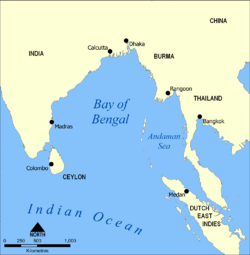Action of 18 November 1809
| Action of 18 November 1809 | |||||||
|---|---|---|---|---|---|---|---|
| Part of the Napoleonic Wars | |||||||
|
Location of the Action of 18 November 1809 |
|||||||
|
|||||||
| Belligerents | |||||||
|
|
|
||||||
| Commanders and leaders | |||||||
| Jacques Hamelin | John Stewart | ||||||
| Strength | |||||||
| frigates Vénus and Manche, brig Créole | East Indiamen Windham, United Kingdom and Charlton | ||||||
| Casualties and losses | |||||||
| No casualties recorded | 4 killed, 2 wounded, all three ships captured | ||||||
Coordinates: 6°30′N 92°45′E / 6.500°N 92.750°E
The Action of 18 November 1809 was the most significant engagement of a six-month cruise by a French frigate squadron in the Indian Ocean during the Napoleonic Wars. The French commander, Commodore Jacques Hamelin, raided across the Bay of Bengal with his squadron and achieved local superiority, capturing numerous merchant ships and minor warships. On 18 November 1809, three ships of Hamelin's squadron encountered a convoy of India-bound East Indiamen, mainly carrying recruits for the Indian Army, then administered by the Honourable East India Company (HEIC).
Despite spirited resistance from the largest British merchant ship, Windham, the failure of the other Indiamen to support their leader and the size and power of the French ships forced the British to withdraw: all the HEIC ships were subsequently captured by the larger, faster French warships. A month later, Hamelin's raiding campaign skirted disaster when a winter hurricane on the voyage back to Île de France almost wrecked his flagship Vénus. Vénus only survived with the co-operation of the British prisoners aboard, who brought the ship safely to port. Only two of the captured Indiamen were successfully brought to Ile de France: the same storm that nearly destroyed Vénus scattered the squadron and its prizes, allowing a patrolling British frigate to recapture Windham just a few miles from the French island.
...
Wikipedia

